A plant’s name can often help give you a sense of place as to where the plant originated. I’ve been noticing recently that a lot of plants in the garden have species names that are either “californica” or “californicus.” I guess you can’t get much more California than that.
First is our ever-popular state flower, the California poppy, Escholzia californica. Most of you are familiar with this form, the bright orange one that comes in California wildflower mixes. I planted some seed a decade ago, and these come back every year, some where they did the previous year, some a few feet away. But for me they’re not the wandering world traveler that they are for some people. (They’ve naturalized in parts of Chile and are on the pest (but not invasive) species list for Tennessee.)
This year I’m also growing from seed the form of the species that you actually find in this part of the state, Escholzia californica maritima. The flowers are about a third of the size of the orange version, and are gold shading to a yellow-orange. My pampered plants are taking their time flowering, so these are images of plants in the winds, on the bluffs overlooking the ocean south of Del Mar. Once these start blooming, I’ll probably cut back the orange ones so the two strains don’t hybridize.
And here’s the classic orange poppy in the garden growing in the middle of a prostrate form of California sagebrush, Artemisia californica ‘Canyon Gray.’ While most of the forms of sagebrush are, well, brushy and upright, this selection from the Channel Islands off the coast of Ventura grows near the ground and sprawls a bit. The plant can get a little leggy in the middle, so a well-placed volunteer poppy seedling can be the best way to conceal that fact.
I wrote last year about this wild ranunculus, Ranunculus californicus, or California buttercup. It disappears not long after flowering, but it’s a nice presence during early spring.
The coast sunflower, Encelia californica, continues the yellow-to-orange theme. My plants were planted only recently and aren’t blooming yet. This is a stand of it at Torrey Pines Preserve this past Monday, doing just fine with natural rainfall. (It won’t be quite so ornamental once the moisture gives out, however.)
The last one I’ll share today has got to be one of the more spectacular Californians, the bush anenome, Carpenteria californica. The flowers began to open just this week. This species hails from the Sierra foothills where it can become quite the large shrub. My plant has tripled in size in one year, though it’s still not more than three feet tall. It can triple in size again, and then I’m getting the pruning shears. Pretty flowers, though, no?


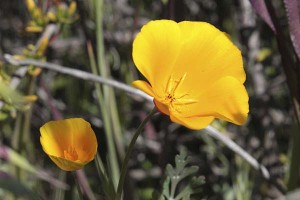
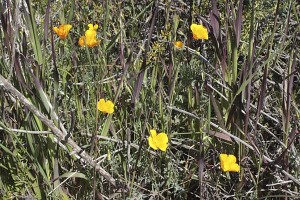
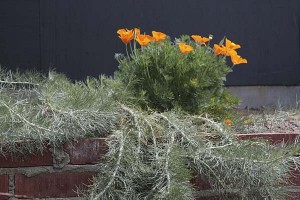
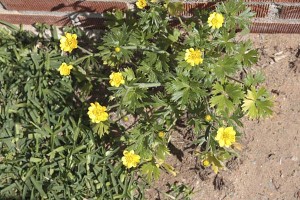
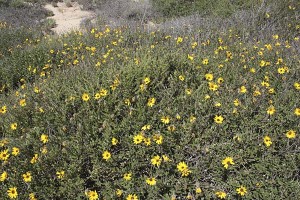
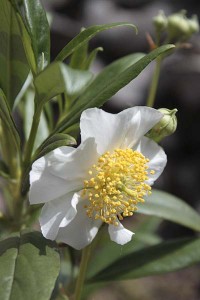
I love the poppies! So cheerful, and bloom a long time without water. I’m hoping for a first bloom in a few days. My carpenteria, which is 6 feet tall, will probably bloom later. Last year one day after the garden tour. Oh well.
i love poppies too! unfortunatly i don’t have a garden-field for them…
I wish I could grow poppies-any poppies! They just don’t like my shade. They are so pretty in the spring!
Love the poppies. I think more people should plant wild flowers. Native plants depending on what type of environment they grew in can be great additions to the garden. Certainly a wildflower that grows in the shade or in wet soil will not grow well in conditions of bright sun or dry soil. I strongly encourage people to check with local plant suppliers. Some nature centers have people you can contact if you want to purchase wild plants or plant seeds.
Town Mouse, maybe this will be the year your carpenteria syncs up with the garden tour? Even though these plant shave been in the nursery trade since the 1800s they still don’t get the recognition they deserve.
Beaudamau, I’ve seen poppies in pots, so I could see a few on your veranda–if only you had the space for one more plant!
Tina, too bad for the shade, but you’ve definitely got some great other options. And just think of the cooling shadows in the heat of summer…
Charles, good points. So many of the natives would be great choices for the garden. Most of the ones I featured would work well in sunny and dry spots in the garden, but there are many native choices that would be happy in wet or dry shade.